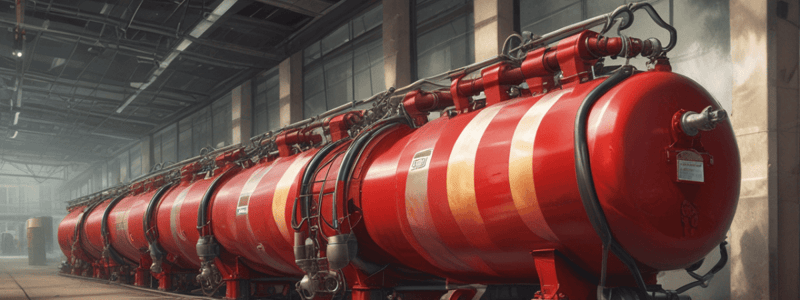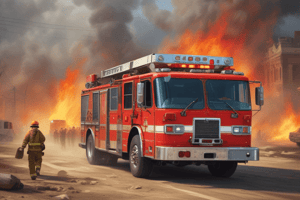Podcast
Questions and Answers
Why is the booster tank attack emphasized in water supply priorities?
Why is the booster tank attack emphasized in water supply priorities?
- It can be implemented only in urban areas.
- It limits water usage to less than 200 gallons.
- It allows for earlier fire control. (correct)
- It requires less manpower.
What is the estimated amount of water typically required to control residential structure fires?
What is the estimated amount of water typically required to control residential structure fires?
- 100 to 200 gallons
- 400 to 500 gallons
- 500 to 600 gallons
- 200 to 300 gallons (correct)
What does Plan A specify for the first-due engine's response?
What does Plan A specify for the first-due engine's response?
- It must always lay a reverse line.
- It should establish its own water supply if possible. (correct)
- It should wait for the second-due engine.
- It should use a private water source.
What action does Plan B recommend if the first-due engine cannot get close enough to a hydrant?
What action does Plan B recommend if the first-due engine cannot get close enough to a hydrant?
How much water can booster tanks typically hold to ensure a safety factor during firefighting?
How much water can booster tanks typically hold to ensure a safety factor during firefighting?
What is one advantage of early hoseline deployment mentioned in the content?
What is one advantage of early hoseline deployment mentioned in the content?
What is a key advantage of using a reserve lay?
What is a key advantage of using a reserve lay?
Which scenario is a disadvantage of the forward lay by the first due engine?
Which scenario is a disadvantage of the forward lay by the first due engine?
In what situation is a reverse lay most effective?
In what situation is a reverse lay most effective?
What must occur for the second due engine to assist in the incident operations under the booster back up plan?
What must occur for the second due engine to assist in the incident operations under the booster back up plan?
What happens when the second due engine is not available during initial operations?
What happens when the second due engine is not available during initial operations?
What is a primary disadvantage of the reverse lay in certain locations?
What is a primary disadvantage of the reverse lay in certain locations?
What is necessary for a hydrant to provide its full water supply potential?
What is necessary for a hydrant to provide its full water supply potential?
What happens if a hydrant is not supported?
What happens if a hydrant is not supported?
Which phrase best describes the relationship between hydrant support and water supply?
Which phrase best describes the relationship between hydrant support and water supply?
In what situations is the volume of water available from a hydrant considered inadequate?
In what situations is the volume of water available from a hydrant considered inadequate?
Why is it critical for firefighters to ensure hydrants are supported?
Why is it critical for firefighters to ensure hydrants are supported?
What is a primary consideration when assessing hydrant functionality?
What is a primary consideration when assessing hydrant functionality?
What is the overall impact of not having a supported hydrant in emergency situations?
What is the overall impact of not having a supported hydrant in emergency situations?
What is not a factor in determining the effectiveness of a hydrant's water supply?
What is not a factor in determining the effectiveness of a hydrant's water supply?
Flashcards are hidden until you start studying
Study Notes
Water Supply for Fire Mitigation
- Effective water supply is crucial for incident mitigation; however, it should not delay immediate response actions.
- "Fast water" through booster tank attacks is prioritized to enhance life safety and fire suppression.
- Booster tank attacks significantly improve suppression capacity, allowing for flow rates that are effective in residential fires, typically controlling fires with 200 to 300 gallons.
- With 1,000-gallon booster tanks, a safety factor of approximately 4:1 is achieved, allowing for aggressive fire control and safety assessments for rescues.
- Early fire control through hoseline deployment leads to reduced fire growth, aligning with the second objective of stabilization.
Water Supply Algorithm and Plans
- A water supply algorithm provides multi-step plans (A through D) starting with the booster tank attack.
Plan A: First-Due Engine Takes Its Own Hydrant
- If within 200 feet of a hydrant, the first-due engine will establish its own water supply.
- Engine companies should consider hydrant location for optimal apparatus placement, helping maintain access for truck placement.
Plan B: Reverse Lay
- If the first engine cannot reach the hydrant, the second-due engine completes water supply while ensuring better positioning for the truck.
- Personnel from the second engine exit to prepare for action promptly upon arrival.
Apparatus Operator Responsibilities
- Operate in minimal turnout gear while establishing water supply; proceed to hydrant unless relay operation is needed.
- Maintain pump redundancy by having a pumper at the hydrant ready to support the attacking pump in case of mechanical failure.
- Advantages of reserve lay include faster personnel readiness, lesser scene obstruction, enhanced flow capacity, and operational redundancy.
Forward Lay Strategies
- Forward Lay by Second Engine with Booster Backup: Second-due engine shares booster tank water, increasing total initial water supply to 2,000 gallons while maintaining operational readiness.
- Forward Lay by First Due Engine: Historically used but causes delays in engine arrival and initial attack line deployment, ultimately reducing overall water supply effectiveness.
Access to Water Supply
- Full water supply potential from hydrants depends on their support and operational readiness; unsupported hydrants often limit usable water volume during incidents.
Studying That Suits You
Use AI to generate personalized quizzes and flashcards to suit your learning preferences.




